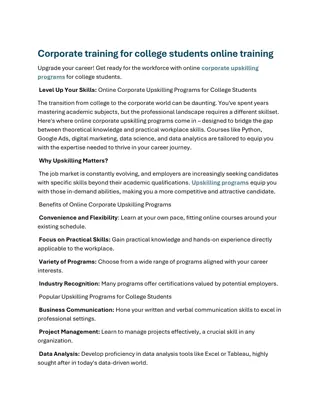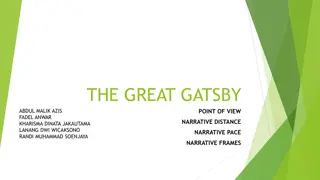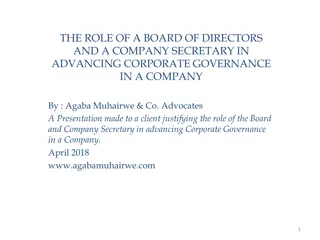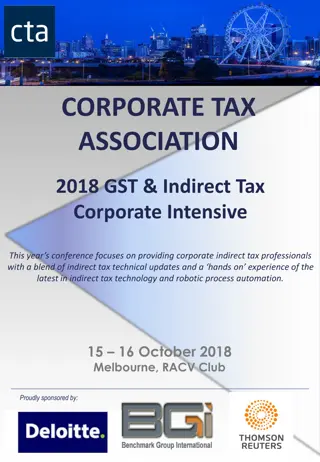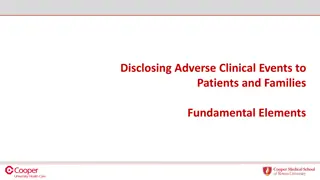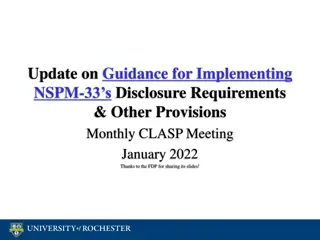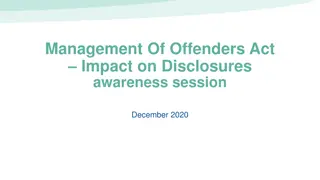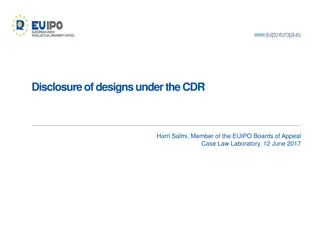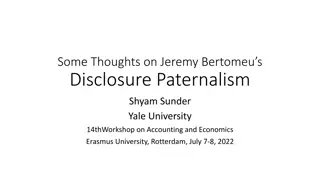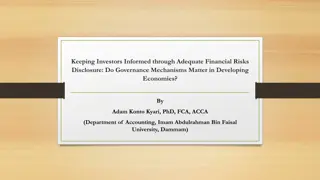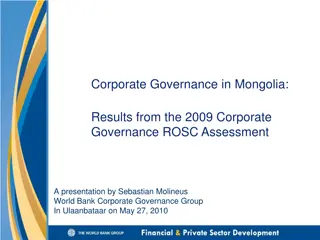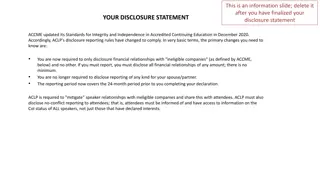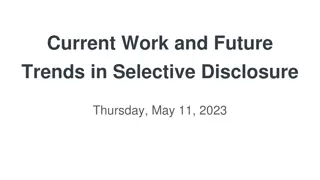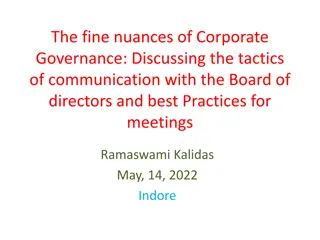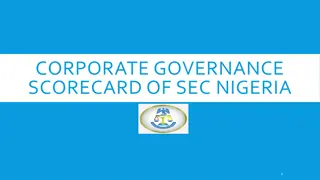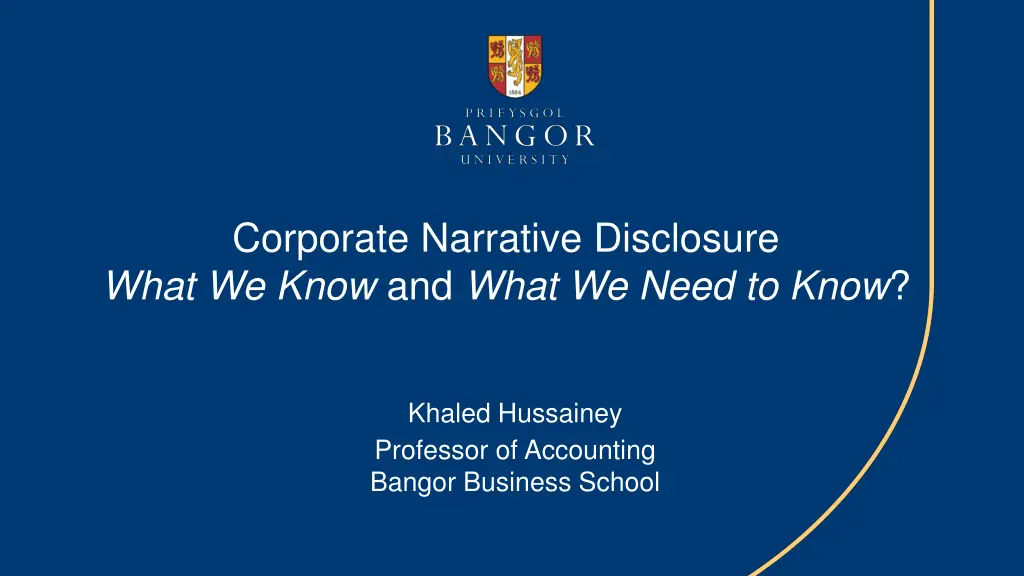
Understanding Corporate Narrative Disclosure and Its Importance
Explore the concept of disclosure in corporate settings, including mandatory versus voluntary disclosure, numbers versus narratives, and the growth in voluntary narrative disclosure. Understand why corporate narrative reporting is essential for communicating crucial information that financial statements alone may not capture.
Download Presentation

Please find below an Image/Link to download the presentation.
The content on the website is provided AS IS for your information and personal use only. It may not be sold, licensed, or shared on other websites without obtaining consent from the author. If you encounter any issues during the download, it is possible that the publisher has removed the file from their server.
You are allowed to download the files provided on this website for personal or commercial use, subject to the condition that they are used lawfully. All files are the property of their respective owners.
The content on the website is provided AS IS for your information and personal use only. It may not be sold, licensed, or shared on other websites without obtaining consent from the author.
E N D
Presentation Transcript
Corporate Narrative Disclosure What We Know and What We Need to Know? Khaled Hussainey Professor of Accounting Bangor Business School
What do we mean by disclosure? - Disclosure refers to information made available by insiders (managers) to outsiders (stakeholders). - It refers to the dissemination of information by a firm, which may be financial or non-financial, quantitative or qualitative, mandatory or voluntary, and communicated through formal or informal channels. This information is shared with the public in general and, more specifically, with a targeted group of information users, such as stakeholders, including investors, analysts, and creditors.
Disclosure can be: Mandatory or Voluntary Mandatory disclosure: disclosure required by accounting standards and accounting requirements such as financial statements: Income statement Statement of financial position Cash flow statement Statement of change in equity Notes to financial statements Voluntary disclosure: any disclosure over mandatory disclosure Not required by accounting standards Provided voluntarily by companies Help investors to know more about the company
Disclosure can be: Numbers or Narratives Vodafone Plc: Income statement
What we already know (established research and practices).
The Growth in Voluntary Narrative Disclosure The Growth in Voluntary Narrative Disclosure - Financial statements lost their relevance and hence traditional accounting model no longer satisfies users needs (Lev, 1989). - Call for a comprehensive model of business reporting that includes forward-looking information relating to strategy and risk, non-financial performance measures and soft, narrative information relating to intangible assets and the value creation process, to complement the financial information on outcomes.
Arguments for Corporate Narrative Reporting 1) It is used as a tool to communicate what cannot be delivered by financial statements. Financial statements do not include all types information Information in the financial statements is purely historical It complements financial statements and allows managers to convey information not recognized in financial statements (e.g., Forward- looking information) It provides a discussion of the amounts in the financial statements. It provides useful context to understand the financial statements amounts
Arguments for Corporate Narrative Reporting 2) It reduces the information asymmetry problem between managers and stakeholders Managers know much more information about the company than investors (information asymmetry) To reduce this information asymmetry problem, managers provide more information to investors in the form of narrative discussion It is a mean for managers to convey their perspectives of the firm to outside investors.
Arguments for Corporate Narrative Reporting 3) The most important source of information for different stakeholders Financial analysts depend on narrative discussion and analysis in the annual report in preparing their reports Potential investors analyse narrative reporting statements when making their decisions
Arguments against Corporate Narrative Reporting - Corporate narrative reporting might affect the company s competitive advantage. - Managers may use narrative reporting to mislead investors (risks of greenwashing or biased disclosures) - Narrative reporting may provide a disclosure medium for managers to engage in impression management practices. Impression management is regarded as attempts to manipulate the impression conveyed to users of accounting information . In the narrative disclosure, bad information could be provided in a good way
Disclosure studies Disclosure studies Empirical literature, covers: descriptions of actual practice, studies of the disclosure decision (determinants) the capital market and non-capital market consequences of those decisions (links to the Market Based Accounting Research (MBAR) research area, including the value relevance literature) (economic consequences).
Disclosure Types Disclosure Types Forward-looking disclosures. Disclosure Tone (Good news/bad news). Risk disclosures. Key Performance Indicators (KPIs) disclosures. Intellectual capital disclosures. CSR/ESG/SDG disclosures Corporate governance disclosures Anti-money laundering disclosures. R&D/innovation disclosures Covid-related disclosures. Brexit-related disclosures. Technology-related disclosure (e.g. Fintech disclosure, blockchain disclosure, cybersecurity risk disclosure). CSR-related disclosure (modern slavery; circular economy, waste management, climate change, etc). Until early 2000s, researchers focused on the overall level of corporate narrative disclosure
Disclosure channels Corporate disclosure can take many forms such as Annual reports, Interim reports (semi-annual/quarterly/monthly reports) Conference calls provided by the company (e.g., include new information about the company s products) Internet disclosure (online reporting): disclosure on companies websites Press Release Face-to-face meetings with analysts Social media (Facebook, Twitter, ) The official channel for disclosure is the annual report. All companies should publish their annual reports
Empirical methods used Survey Archival (regression analysis; content analysis) (quantitative) Mixed approach (quantitative and qualitative) Questionnaire (quantitative) Interview (qualitative) Majority of the studies Few studies Few studies
Theoretical Underpinnings - Agency theory - Signalling theory - Capital need theory - Resource dependency theory - Stakeholder theory - Legitimacy theory - Institutional theory - Impression management theory - Information cost theory - Political cost theory . Other theories
Corporate Narrative Disclosure Measurement Disclosure indices studies: Researchers identify disclosure items and look for presence/absence (scored 1/0) measures variety, not volume (quantity). Does not look at the content of the information. Sometimes scoring tries to capture differential quality of item disclosure detailed disclosure/brief disclosure/not disclosed (scored 2/1/0). Items in indices may be unweighted or weighted (to capture the importance of the item).
Corporate Narrative Disclosure Measurement Management earnings forecasts are frequently used by US researchers as a proxy for disclosure quality. However, these forecasts are only one component of managers voluntary disclosure package. Companies voluntarily publish different types of information in their annual reports. Therefore, it is not sensible to use this type of information as a proxy for the overall level of corporate disclosure quality.
Corporate Narrative Disclosure Measurement Subjective ratings such as: AIMR-FAF ratings (analyst opinion, bias!) Financial Post ratings Australian Stock Exchange ratings Society of Management Accountants of Canada (SMAC) ratings SEC ratings Actualidad Economica ratings Center for International Financial Analysis and Research (CIFAR) ratings
Example: Example: What measures do researchers What measures do researchers use to assess sustainability in use to assess sustainability in organizations? organizations? Aggregated scores: - Subjective ratings such as ESG Bloomberg or pulsora data, Datastream, Eikon, Morningstar, MSCI, Preqin, Boardex, Execucomp.
What measures do researchers use to assess sustainability in organizations? Individual scores: Environmental Social Governance Carbon Emissions: Total greenhouse gas (GHG) emissions, including CO2, methane, and other pollutants. Energy Consumption: Total energy use and the proportion from renewable versus non-renewable sources. Waste Management: Amount of waste generated and recycled, including hazardous waste handling. Human Rights and Labor Practices: Compliance with labor laws, non-discrimination policies, and fair labor practices across the supply chain. Community Engagement: Contributions to community development, including charitable donations, volunteering, and local partnerships. Product Responsibility: Measures of product quality, safety, customer satisfaction, and data privacy and security. Board Composition and Diversity: Independence of the board, gender diversity, and board expertise. Executive Compensation: Alignment of executive pay with sustainability performance and long-term goals. Ethics and Anti-Corruption: Policies and practices related to ethical conduct, transparency, anti-corruption measures, and compliance with laws.
Corporate Narrative Disclosure Measurement Content Analysis - Disclosure quantity as a proxy for disclosure quality. Assumes that disclosure quality and disclosure quantity are positively related. - Disclosure quantity is measured by the frequency of specific information disclosed . However, reporting more information in the annual reports does not mean that it is understandable or easy to read! Manual Content Analysis Computer-based Content Analysis
What drives companies to increase levels of What drives companies to increase levels of corporate narrative disclosure? corporate narrative disclosure? Firm-Specific variables Corporate governance mechanisms Country-specific variables Firm size Firm age Liquidity Profitability Leverage Industry type Dividend payment Firm growth rate Board characteristics Audit committee characteristics Ownership structure GDP Corruption levels Culture dimensions Determinants of corporate narrative disclosure. Determinants of corporate narrative disclosure.
What benefits do companies gain from providing more narratives to What benefits do companies gain from providing more narratives to stakeholders? stakeholders? Firm-Specific benefits Benefits to investors and financial analysts Benefits to other stakeholders - Improve firm value/stock market performance. Improve investors ability to predict future earnings. Improve analysts forecast accuracy. Important for financial analysts recommendations. - Trade credit received from suppliers. Credit ratings. - - Financial performance. Sustainability performance/Environmental performance/Social performance Firm risk Investment efficiency Cash holdings Tax avoidance (greenwashing) Earnings management (greenwashing) Accounting conservatism - - - - - - - - - - - Dividend payment Economic Consequences of Corporate Narrative Disclosure. Economic Consequences of Corporate Narrative Disclosure.
What benefits do companies gain from providing What benefits do companies gain from providing more narratives to stakeholders? more narratives to stakeholders? The moderating role of: - Ownership structure - Digital transformation - Size - Age - Gender diversity - Information and communication technology expenses - CEOs overseas experience
A major gap in Corporate Narrative Reporting literature It is assumed that disclosure quantity is a proxy for disclosure quality.
Empirical research on the impact of disclosure on cost of capital, however, offers mixed results. Kothari et al. (2009:1640) reviewed prior research on the impact of disclosure on the cost of capital and concluded that: Evidence is mixed in the few studies that examine the issue (e.g., Botosan 1997; Botosan and Plumlee 2002; Francis et al. 2005; Core et al. 2008). Conclusions from previous research on the effect of disclosures in the annual report (e.g., Botosan 1997) on the cost of capital are unconvincing because disclosures analysed in previous research are far from comprehensive and the measurement of disclosure proxies is generally subjective, not objective .
Beattie et al. (2004: 233) argue that: Researchers investigating the determinants and consequences of disclosure quality could be wasting their effort if the primary variable of interest [disclosure] is not being measured with a sufficient degree of accuracy .
Beyer et al. (2010:311) review prior research on different proxies for disclosure quality and conclude that: a disclosure/ financial reporting quality and direct derivation of measures from that definition is missing from the literature. This lack of an underlying economic definition hinders our ability to draw inferences from this work, and we recommend that future research address this issue . sensible economic definition of voluntary
Disclosure quality is A complex, multi-dimensional, context-sensitive and subjective concept . (Beattie et al, 2004). Measuring disclosure quality has been regarded as an extraordinary difficult. (Botosan, 2004 and Beretta & Bozzolan, 2004).
A suggestion for measuring disclosure quality The development of a disclosure quality framework should begin with well-supported and convincing discussions of the characteristics of information that define disclosure quality and why the characteristics selected are essential ingredients of disclosure quality (Botosan, 2004).
A measure for disclosure quality should consider the qualitative information attributes proposed by the International Accounting Standards Board (IASB): - Relevance - Faithful representation - Understandability - Comparability - Timeliness Prior research has examined these attributes individually, but few have developed a comprehensive measure that incorporates all of them.
UK OFR Qualitative Information Attributes Forward-looking orientation Supplement and complement financial reports. Comprehensiveness Understandability Balance and Neutrality Comparability Relevance Timeliness Verifiability Prior research has examined these attributes individually, but few have developed a comprehensive measure that incorporates all of them.
The research focused on three qualitative information attributes: -Relevance. -Understandability. -Balance and Neutrality.
The research focused on three qualitative information attributes: Relevance (e.g. the existence of forward-looking financial information or non-financial information). However, Relevance for whom? Information that is relevant to an investor may not hold the same relevance for a particular category of stakeholder! An institutional investor interested in socially responsible companies as an investing target, may also need historical information about the social activities of the firm and thus this information becomes very relevant.
The research focused on three qualitative information attributes: -Readability. -Researchers have used readability as a proxy for understandability. -However, even if information is easy to read, it does not necessarily ensure that there is no guarantee that stakeholders will find it easy to understand.
The research focused on three qualitative information attributes: -Balance and Neutrality (disclosure tone). - However, in many cases, 95% of the information disclosed contains Good News, with only 5% covering bad news (disclosure bias). - Managers often attribute good news to themselves, while attributing bad news to external factors (attribution bias).
What remains to be explored (gaps and future directions)?
Future research Future research Emerging Trends and Opportunities - Measuring disclosure quality is a challenge. - New measures are needed to assess the quality and impact of narrative disclosures. - The use of AI-driven Textual Analysis in measuring the quality of corporate narrative disclosure in annual reports and social media.
Future research Future research Stakeholder Perspectives - Qualitative research is needed to understand how different stakeholders interpret and value narrative disclosures. - Qualitative research is also needed on challenges to corporate narratives reporting in the digital age.
Future research Future research Non-economic consequences of corporate narrative disclosure - There is a need to examine the non-economic consequences of corporate narrative disclosure disclosure (its impact on customer satisfaction or employees).
Future research Future research External Assurance - Research is needed to explore the external assurance on corporate narrative disclosures and the extent and scope of the assurance that should be provided. We need an answer to the following question: Whether and, if so, how assurance should be provided on such information?
Future research Future research More research is needed on the determinants and consequences of: - Modern slavery disclosure. - Circular Economy disclosure. - Cybersecurity disclosure. - Technology-related disclosure such as Fintech disclosure; and Blockchain disclosure.
Future research Future research Sector-Specific Insight: - Research is needed to understand sustainability and technology-related disclosure practices of different industry sectors such as: - Healthcare sector. - Sport Sector. - Airlines Sector.
Future research Future research Alternative sample splits could offer interesting stories: - pre- and post-crisis data. - pre- during and post-Covid 19. - Loss-making companies versus profit-making companies. - High-growth companies versus low-growth companies. - High-quality governance versus low-quality governance.
Future research Future research Information withholding -It is interesting to explore what drives companies to withhold quantitative information in their annual reports and how this impacts stakeholders.
Future research Future research Disclosure by stakeholders. It is interesting to explore what information is used by: - External auditors (Taffler, R. J., Lu, J., & Kausar, A. (2004). In denial? Stock market underreaction to going-concern audit report disclosures. Journal of Accounting and Economics, 38, 263-296.) - Financial media reports (Taffler, R. J., Agarwal, V., & Obring, M. (2024). Narrative Emotions and Market Crises. Journal of Behavioral Finance, 1-21.) - Financial analysts (Tan, K. L., Imam, S., & Babu, M. M. (2019). The use of information by financial analysts during a financial crisis. Strategic Change, 28(5), 369- 379).
Future research Future research Disclosure by stakeholders. It is interesting to explore what information is used by: - Fund managers (Darendeli, A. (2024). How do retail investors respond to summary disclosure? Evidence from mutual fund factsheets. Review of Accounting Studies, 1- 45). - Employees (Hales, J., Moon Jr, J. R., & Swenson, L. A. (2018). A new era of voluntary disclosure? Empirical evidence on how employee postings on social media relate to future corporate disclosures. Accounting, Organizations and Society, 68, 88-108).
Call for papers - The British Accounting Review Artificial Intelligence in Sustainable Finance and Accounting Submission deadline: 31 March 2025 Accounting for Sustainable Finance: Legislating to Advance Impact and Mitigate Greenwashing Submission deadline: September 1st, 2025 - International Journal of Accounting Special Issue on Corporate Governance and Sustainability Disclosure Submission deadline: March 31, 2025
Khaled Hussainey Professor of Accounting Bangor Business School Bangor University Email: K.Hussainey@Bangor.ac.uk


